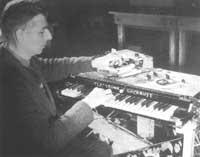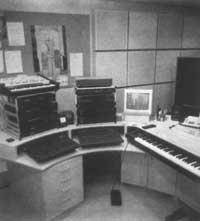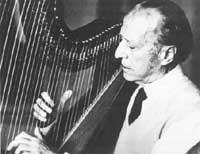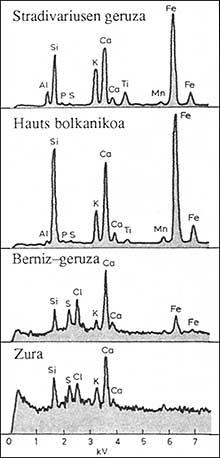Synthesizing the sound of music
1992/09/01 Taylor, Charles Iturria: Elhuyar aldizkaria
In the 1930s a quite strange feeling arose between physicists and musicians and I fear that the pride of physicists did not have much to do with it. According to physicists, the operation of the instruments was based on the theories of the vibrations of the columns and the air wires. The secret of cellos and cellos made by Antonio Stradivari in the eighteenth century would not last long.

The debate became fashionable in 1932, when the first electronic organs were made. The advance of the physicists was remarkable, but the musicians echoed the new sounds. Physicists could analyze the simple notes produced by mechanical systems by playing authentic instruments in the laboratory and explain some of their characteristics. The reason for the differences of timba between instruments also began to be perceived. From these first ideas on the nature of sounds, the electronic imitation of a simple and stable note of a conventional tool was addressed.
After sixty years, acoustics have had to recognize that “real” music is extremely complex. There is a big difference between the sound produced by a violinist when playing in a concert hall and the sound of separate notes produced by an instrument.
However, in the last 15 or 20 years, the synthetic sounds that once set the musicians on fire have contributed to a better understanding of the physical basis of traditional instruments, which has resulted in a better relationship between the members of both areas.
In the 1930s, physicists studied the sound waves generated by musical instruments using oscilloscope.
In the books of the time the waves of some musical instruments appeared, relating the “quality” of sound to the size of the wave. The waves were relatively regular and, using a mathematical technique based on Fourier analysis, demonstrated that each wave was the sum of several frequencies. Likewise, it was verified that each of these sets of frequencies was formed by a fundamental frequency and by the multiple harmonics thereof. The first electronic organs could reproduce the exact shape of the real wave by superimposing different harmonic combinations on a base type. Why was the result so poor musically?

The problem was that the wave described for each instrument was carried out by studying a very short sample, often only for hundredths of a second. Because if we take longer samples, such as those of tenth of a second or of a second, it is easily appreciated that the waves of the real instruments are not regular for a long time. The synthesized sounds of the electronic organs were obtained by extending the sample in hundredths of a second to the entire duration of the note and, of course, the results could not be close to the real. The note that creates a true instrument is characterized by the beginning of sound. A real system cannot start to vibrate sharply and there is also a big difference between how the vibration starts from one instrument to another.
For example, when we blow into the oboe, the tongue of the instrument expands and closes. Thus, the air enters the tube not be as continued, as a pressure air could as a succesion. Each air unit circulates through the tube and when it reaches a hole it expands outside the apparatus. However, some of the energy remains in the tube and returns to the bottom, to the canvas. The tongue will continue to vibrate only if the returned air hits the tongue at the proper time of the vibratory cycle. Air must travel between 10 and 20 times to adjust to the vibration frequency of the tongue. For a note of 440 hertz, 20 displacements will take less than a twenty part of a second, but that time is enough for the listener to perceive it and, after all, know the sound of the tool, which is an initial sound different from the other devices.
This initial ephemeral sound is one of the most outstanding features of the entire note, and only when synthesizers were able to imitate glued to the stable note, did it begin to get something similar to real sounds. In the mid-1950s they began to mimic this kind of sounds, but the synthesizers of the market have been successful in the last 10 years.
Another significant event is the change of amplitude or “vibration” that occurs during a second in the note of an instrument. It can be a vibrato made by the player himself, but when it is not done, small vibrations are perceived. In fact, it is very difficult to fully control the pressure and speed that is performed with the bow on a wind instrument or on a rope instrument. To create a stable note, the player must compare the note he is creating at a certain time with that of the previous moment. Listening and processing information requires a time between a second and a fifth, and thanks to the resulting vibration, the human ear clearly distinguishes the real sound from the electronic.
In the 1930s, samples lasting only one hundredsecond were designated as “flute wave image” or “clarinet wave image”. Consequently, the only difference between two notes was frequency and not form. And that was also an excessive simplification, as it is impossible to create the entire sound field of an instrument. In all this the initial electronic organs were wrong.

Like efforts to simulate real tools, some advances in modern technology have contributed to better understanding them. Frequency analyzers once required long sound samples, but at present we have practically instantaneous “real-time” analyzers. In sounds converted analog to digital using new techniques, computers can perform different types of analysis. Moreover, instrument vibrations can be analyzed by holographic interferometry or computer simulation.
The clarinet is perhaps the wind instrument that has studied physics the most. At one time it was stated that the characteristic sound of this instrument was because there were no harmonic pairs. Basic physics clearly shows that the cylindrical tube, closed at one end, only produces odd harmonics, and physicists believe that the clarinet, being cylindrical and with the tongue closed, would act like that. However, frequency analyses have shown the existence of even harmonics and the different harmonic composition of each note.
Research has clarified that the reason is that the tube is not completely cylindrical, since the holes that are closed create “bleeding” inside the tube. The arrangement of the closed and open holes is different for each note, which influences the composition of the inner tube wave and the output form of the sounds. Much of the sound is extracted from open holes and interference occurs between the waves that are ejected through adjacent holes. Therefore, each note is “unique”. The first electronic organs used the same recipe for all notes.
In string instruments, the way the instrument soul amplifies the harmonic components of thread vibration is very important. And as in wind instruments, for each note occurs different. A bad violin makes big amplification changes from one note to another and it is difficult to control the instrument. However, a fully uniform amplification, which can be obtained electronically, produces an unpleasant sound. As for Agi, our ear prefers some irregularity. We do not know, however, to please the player and the listener, to what extent these levels of irregularity are necessary.
So far there is no formula for it. The secret of the good violin is in the proper texture of the dimensions, in the thickness and curvature of the wooden plates, in the characteristics of elasticity, humidity and other materials. Physicists look how and how they can help violinists improve their products.

The latest studies of traditional instruments are used for the design of leading computers. The breakthrough has occurred in the initial transient sound of the note. In a string instrument like the violin, this principle is limited by the way the bow oscillates the thread and the body begins to vibrate. Body wood cannot begin to vibrate sharply, the vibrations of the previous note must be interrupted as the new note begins. The body's ability to change frequently is characteristic of the good violin. On many occasions, violinists say that with a violin that is so fast, it is “faster response.” This is one of the main hallmarks of the Stradivarius.
In the 1950s, initial synthesizers were built to change a note over time using a tool called envelope shaper. It was a normal circuit that increased and reduced a note at a certain speed. But until the early 1970s no one realized that this was a much higher control. What was really needed was a way to increase and decrease the different harmonics of a note at different speeds. Gradually it became clear that each note of an instrument needed a different harmonic composition and a different speed of increase and reduction for each harmonic.
The last electronic keyboards, in addition to making this type of changes in the components of the note, can introduce the sound of the breath or the movement of the player's keys, introduce the sound of the movements of the instrument or the keys to get closer to the real timbre of the instrument. They produce a lot of impressive sounds, but they usually come from banks of real sounds accumulated on the computer. Are they true synthesizers or only tools that collect, sort and combine real sound samples? Physicists can hardly resist total victory.
However, electronic synthesizers have not made a short way since the 1930s. In the 1970s, the main breakthrough was the controlled electrical voltage elements (the previous devices had a “dial” to control frequency or amplitude in a wave generator). In a controlled voltage element, the frequency or amplitude varies according to the established voltage. For example, the keyboard would be just an instrument that applies some tension to a sound generator every time a key is pressed. The vibrato would be obtained by an oscillation of tension that would cause a vibration in frequency and/or amplitude.
In the 1980s, the remarkable breakthrough was probably the so-called ‘Musical Tresna Digital Interface’ (MIDI, digital interface of musical instruments). It is an almost universal digital language or “protocol” through which almost any digital instrument can control another or control it by another. For example, in the “Royal Institution Christmas Lectures” I was left with several electronic musical instruments from different manufacturers. All had the three heads of five midi-in, midi-through and midi-out needles. If we associate the output of a digital keyboard from a home to the input of a digital sampler from another home, the keyboard could use the sounds in the sampler. Using the “Through” connection, some instruments can be joined in a chain forming an “orchestra” that controls the first instrument.

The BBC's most modern recording room consists of different synthesizers, samplers and other sound sources, all linked to a complete keyboard and a powerful computer using the MIDI system. The composer can produce sounds, mix in different ways and perform a complete composition. All details are stored on the computer and can be reused, modified, augmented or replaced. When the result is correct it is recorded on tape.
Until recently, most electronic tools were taken from the keyboard. Thanks to MIDI, it can be done in many ways and the musician will often pass “closer”. For example, there are drivers similar to the clarinet, with the keys in the same place and with something similar to the simple tab nozzle. The end consists of sensors that respond to the pressure of the lips and the speed of the air and the keys are electronic devices connected by MIDI with the synthesizer.
I don't think the synthesizers take space from the actual orchestras, but it's also true that they have advantages. A synthesizer organ will not have, if necessary, the sound of the true, but may be sufficient for certain purposes. The electronic keyboard is worth considerably less than the piano and can be equipped with a force sensitive key system currently exerted. It can be said that they are equivalent to the current harmonics of yesteryear. But perhaps the most interesting thing is that they produce many new sounds and a composer can use them alongside the sounds of traditional instruments.
When we listen to music what our brain really does, we don't know for now. It is incredible how quickly we separate the sound produced by the machines. The rhythm box associated with some keyboards is an example of this. Thanks to the latest synthesizers we have greatly increased the number of sounds available, but I believe that the physics of music will never make obsolete the contributions of musicians.

Gai honi buruzko eduki gehiago
Elhuyarrek garatutako teknologia




